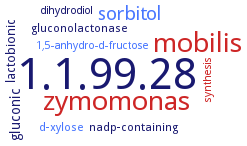1.1.99.28: glucose-fructose oxidoreductase
This is an abbreviated version!
For detailed information about glucose-fructose oxidoreductase, go to the full flat file.

Word Map on EC 1.1.99.28 
-
1.1.99.28
-
zymomonas
-
mobilis
-
sorbitol
-
gluconic
-
lactobionic
-
nadp-containing
-
gluconolactonase
-
d-xylose
-
1,5-anhydro-d-fructose
-
synthesis
-
dihydrodiol
- 1.1.99.28
- zymomonas
- mobilis
- sorbitol
-
gluconic
-
lactobionic
-
nadp-containing
- gluconolactonase
- d-xylose
- 1,5-anhydro-d-fructose
- synthesis
-
dihydrodiol
Reaction
Synonyms
EC 1.1.1.99, GFOD2, GFOR, glucose fructose oxidoreductase, glucose-fructose oxidoreductase, glucose-fructose oxidoreductase domain containing 2, Glucose-fructose transhydrogenase, NADP(H)-dependent glucose-fructose oxidoreductase, Transhydrogenase, glucose-fructose
ECTree
Advanced search results
General Stability
General Stability on EC 1.1.99.28 - glucose-fructose oxidoreductase
Please wait a moment until all data is loaded. This message will disappear when all data is loaded.
enzyme activity loss in pineapple juice is even stronger (18%) than in 0.5 M sugar solution
-
glucose-fructose oxidoreductase (GFOR)/glucono-delta-lactonase (GL) enzyme complex immobilized on Ca-alginate is stable for at least 23 cycles
guanidinium hydrochloride inactivates by induction of structural transitions that are comparable to that observed during substrate turnover. This leads to time-dependent formation of high-order associates and consequently inactivation
-
in absence of substrates or in presence of only one substrate, either fructose or glucose, the enzyme is fully stable
-
inactivation during substrate turnover. The process of inactivation is triggered by structural transitions that are induced by the lactone product and involves aggregation as the ultimate cause of irreversible inactivation
-
the interaction of the enzyme with the aldonolactone product triggers a sequential process that affects the protein structure conformationally and chemically and, ultimately, results in an irreversible loss of activity
-
thiol reagents stabilize. Dithiothreitol is the most efficient, 5-15 mM
-
urea, 1.0 M, prevents the formation of high-order associates and increases the half-life under operational conditions 10fold
-


 results (
results ( results (
results ( top
top





